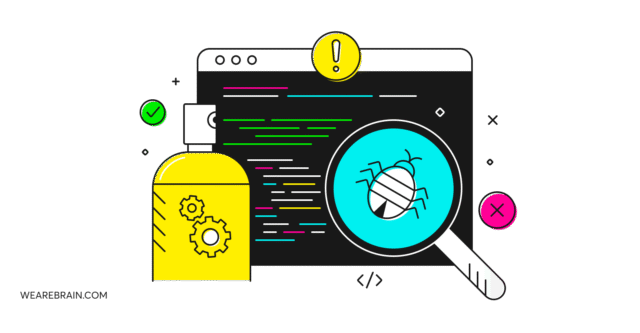
Unlock higher coding efficiency with our top 10 debugging strategies, essential for every developer’s toolkit.
Key Takeaways
- Debugging represents a significant and challenging phase in the software development lifecycle, often consuming more time than the initial code creation.
- Mastery in debugging techniques is crucial for all developers, as bugs are an inevitable part of coding projects.
- Effective debugging involves a detailed process, including understanding error symptoms, identifying the cause, and fixing the error.
- Top debugging techniques include understanding the problem, backtracing, using debugging tools, setting breakpoints, binary search, rubber ducking, log analysis, clustering bugs, taking breaks, and learning from each debugging session.
- These strategies can significantly enhance a developer’s efficiency and problem-solving skills, turning debugging from a burden into a valuable learning opportunity.
- Planning and understanding your code’s purpose before writing can prevent many bugs, saving time and effort in the debugging process.
Catching bugs
No matter your level of experience in programming, encountering bugs in your code is inevitable. Addressing these issues effectively demands a systematic approach, considerable patience and a good debugging strategy.
Debugging is a critical component of software development, often representing the most time-intensive and challenging phase of the coding lifecycle. Interestingly, developers tend to allocate more time to debugging and maintaining code than to its initial creation.
Discover the best debugging techiniques that can elevate your programming efficiency and refine your development workflow.
What is debugging?
Debugging entails the meticulous process of identifying and rectifying errors in software code, which can lead to unexpected behavior. Mastering debugging strategies is crucial for developers, given the inevitability of challenges in any coding project.
But it’s not a situation of proficiency. Even experienced programmers spend a lot of their time debugging. While experience plays a role, a deep comprehension of debugging techniques can significantly enhance your coding efficiency.
Challenges in the debugging process
Before we explore debugging techniques, let’s take a quick look at the outline of a typical debugging process.
Examine the error symptoms
The first step is to successfully identify and understand the symptoms of the issue in your code, such as crashes, error messages, or unexpected behaviour.
Identify the cause
Once the symptoms have been identified, you must then find out the root cause of the problem. This is done by tracing the code’s execution and discovering the specific lines that are creating the issue.
Fix the error
Now that the issue has been identified, it’s time to make the necessary changes or corrections to remove the problem and ensure that the code works correctly.
As you can see, debugging is a detailed process that takes patience and focus. Think of it as finding a needle in a haystack – only that riffling through the digital haystack can potentially cause the displacement of vital elements that could jeopardise the entire ecosystem, creating more needles. To do this effectively, you’ll need a debugging strategy.
10 of the best debugging techniques
To ensure your needles don’t multiply, let’s explore 10 effective debugging strategies to help you become a master at debugging.
1. Understanding the problem completely before taking an action
Before you begin implementing changes to your code, it’s vital to fully comprehend the challenge you’re addressing. Debugging without understanding the problem leads to wasted time and ineffective solutions. Try to reproduce the issue consistently and gather comprehensive information about its behavior patterns and impact.
2. Backtracing
Backtracing, or backward debugging, involves starting from the point where the problem first began and working backwards through the code to find out how and why it happened. This technique is useful if you’re dealing with complex issues that are difficult to trace forward.
3. Using debugging tools
There a hundreds of great debugging tools available in your programming language and environment of choice for you to leverage. These tools help give valuable insights into how your code is functioning, including variables and memory usage, which help save a lot of time. Popular debugging tools like Chrome DevTools, Testsigma, Airbrake, and dbForger are a good place to start depending on your tech stack. Take a look at some of the best debugging tools out there.
4. Breakpoints and stepping
Setting strategic breakpoints in your code where you suspect issues might be hiding allows you to temporarily pause program execution and inspect the state of functionality. Use stepping techniques to move through each line of code methodically, studying variables and data structures for anomalies. This involves carefully examining each line before progressing to understand the flow and identify discrepancies.
5. Binary search
When faced with a complex problem, consider narrowing down the scope of the issue into manageable portions. Binary search is where you divide the code into halves and systematically narrow down the location of the bug. Techniques such as commenting out code, using print statements, or isolating components can help you isolate the problem area quickly.
6. Rubber ducking
Many developers find that explaining the problem to someone else—even an object like a rubber duck—can help identify the issue yourself. The act of articulating the challenge out loud or in writing forces you to think critically about it from fresh perspectives. This process often leads to the discovery of new insights and innovative solutions.
7. Log analysis
Place logging statements strategically throughout your code to provide valuable information for your debugging investigation. By understanding your code’s execution flow and the values of variables at different stages, you become better equipped to identify issues. Explore excellent log analysis tools that can enhance your debugging capabilities and provide deeper insights.
8. Clustering bugs
When you receive multiple error reports, grouping them into classes of related challenges proves more effective than addressing each individually. Bugs in the same category often share common causes or similar patterns. Resolving one challenge from a cluster often addresses others or provides insights into comprehensive solutions.
9. Take breaks
The debugging process can be mentally taxing, especially when you’re stuck on a problem. Taking breaks and stepping away from the code for a while can clear your mind and give you the opportunity to let thoughts and ideas simmer. This can potentially lead to breakthroughs because returning with a fresh perspective often helps you see the problem from a different angle.
10. Take notes for learning
As you embark on your debugging journey (of which there will be plenty), it is not a bad idea to document the process and the solutions you discover. This serves as a valuable resource for future debugging challenges you might encounter. Think of it as an experiential chat code to your debugging endeavours.
It’s important to remember that debugging is a prominent aspect of your career as a developer, so embrace it as a learning opportunity rather than a burden. Each debugging experience will help you grow as a developer and enhance your overall problem-solving skills.
Bonus tip
Don’t write bugs into your code in the first place, silly! We’re kidding, but also not. You see, it’s important to plan before you start writing code. Figure out what you want to do and how you’re going to do it and sketch out a neat algorithm. Make sure it makes sense to you: decide what data structures you’re going to use and what rules you’re going to follow. Trust us, all that brainstorming and planning upfront will save you a ton of time down the road.
Advanced debugging trends shaping 2025
The debugging landscape continues evolving with purpose-driven innovation. AI-powered debugging tools are emerging that can automatically detect patterns, suggest fixes, and even implement solutions. Automated testing frameworks help developers detect challenges more quickly, while collaborative debugging platforms enable teams to work together in real-time to solve complex issues.
Summary
Debugging is an important part of software development and mastering these effective debugging techniques is essential for every successful programmer. By understanding the problem at the onset, you will be better able to develop a strategy to resolve it. Making these approaches part of your go-to debugging strategy will help you become a more proficient debugger.
Remember that debugging is not just about fixing errors – it’s also about understanding your code deeper to become a more skilled developer.
